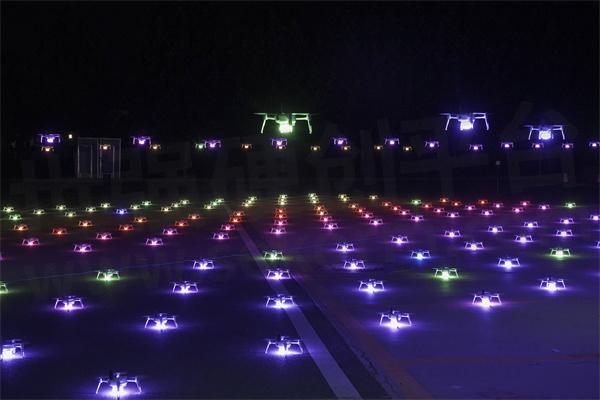How Drone Light Shows are Created and Key Battery Power Requirements

Recently, several breathtaking drone light shows have amazed audiences across various cities, with anywhere from thousands to over 10,000 drones flying in sync, forming dazzling patterns and dynamic visuals. The October 1st performance in Shenzhen, China, which featured over 10,000 drones, earned two Guinness World Records for the "Most Unmanned Aerial Vehicles (UAVs) airborne simultaneously" and the "Largest airborne formation of UAVs." These incredible displays not only highlight the technological advancements of drones but also offer a deeper appreciation of the wonders of modern technology. In this article, we'll explore how these captivating drone light shows are realized and examine the key features required of the batteries that power these drones.

The Technology Behind Drone Light Shows
The execution of large-scale drone light shows hinges on two critical technologies: advanced drone formation flying and precise lighting control. Each drone is equipped with high-precision positioning systems and sensors, enabling them to sense their location and surroundings in real time. This ensures that every drone maintains the correct formation and distance during flight. Pre-programmed instructions allow the drones to rapidly change light colors and intensity, creating mesmerizing visual effects.
To coordinate such large-scale drone formations, a powerful computer system is responsible for directing and managing the entire fleet. This system, equipped with advanced algorithms and models, monitors each drone's flight trajectory and status, including position, speed, and altitude. In the event of any anomalies, the system can intervene immediately, adjusting flight paths or lighting effects to ensure the safety and smooth execution of the show.

How Does the Control System Manage Such Complex Operations?
1. 3D Modeling and Path Planning
The process starts with 3D modeling on the computer. Technicians design various patterns, text, and animations based on the requirements of the show. These designs are then translated into flight paths and lighting instructions that the drones can understand. Advanced algorithms precisely calculate each drone's trajectory to ensure a seamless and orderly performance.
2. Wireless Communication Technology
The computer system uses sophisticated wireless communication technologies, such as IEEE 802.5 token ring network technology, to transmit flight paths and lighting commands to the drones. This system ensures that only one drone communicates with the computer at any given moment, avoiding data conflicts. Each drone processes its specific instructions and passes them on to the next drone, ensuring precise coordination across the entire fleet.
3. Differential GPS Positioning
To maintain precise formations and spacing during flight, the system employs Differential GPS (DGPS) technology. Ground-based GPS reference stations provide real-time corrections to GPS data, allowing drones to adjust their positions with high accuracy, ensuring they follow their pre-set flight paths.
4. Battery Life and Performance Optimization
The control system continuously monitors the drones' flight status, including battery levels. If the battery power drops or performance declines, the system can make adjustments, such as reducing flight speed or dimming the lights, to ensure the show continues safely. Moreover, the system supports various programming languages, enabling technicians to customize and modify the program for more complex and dynamic effects. This allows the drones to form intricate shapes, simulate fireworks, or create effects like shooting stars, providing an unforgettable experience for the audience.
Battery Requirements for Drone Light Shows
Batteries are a vital component of drone light shows, and the following characteristics are essential for them to meet the performance demands:

High Capacity: Ranging from 1500mAh to 6000mAh, the battery must provide sufficient power for extended flight durations. The exact capacity depends on the length of the show and the power consumption of the drones’ lights and motors.
High Voltage: Drones typically use LiPo batteries, with voltage ranging from 3.7V (1S) to 14.8V (4S). Smaller drones may use 1S or 2S batteries, while larger ones may require 3S or 4S batteries.
High Discharge Rate: Drones in light shows usually need a moderate to high discharge rate, between 20C and 45C, to power the motors and lights effectively during the performance. The battery must provide the necessary power for quick LED changes and smooth drone movement.
Fast Charging Capability: Fast charging is crucial to allow quick turnarounds between performances.
Lightweight Design: The battery must be lightweight to maximize flight efficiency and drone maneuverability.
Grepow, a leading UAV battery manufacturer with over 26 years of expertise, specializes in producing high-capacity, fast-charging, and high-discharge rate batteries for drone light shows. Their patented technology ensures smaller, lighter batteries with powerful performance, enabling drones to maintain stability throughout the performance while meeting the demands of various end devices.
This combination of advanced battery technology and sophisticated drone control systems enables spectacular light shows that leave audiences awestruck.
- +1 Like
- Add to Favorites
Recommend
- Application of Friction Stir Welding Technology in Battery Tray Manufacturing
- What are the Drone Smart Battery Protocols?
- Batteryfree, Wireless Light Switch Module Based on KNX-RF Technology
- Maxell‘s All-solid-state Battery PSB401010H Adopted for the Intelligent Image Recognition Unit “iXAM Vision Engine”
- Energy Harvesting – No Batteries, No Wires
This document is provided by Sekorm Platform for VIP exclusive service. The copyright is owned by Sekorm. Without authorization, any medias, websites or individual are not allowed to reprint. When authorizing the reprint, the link of www.sekorm.com must be indicated.





























































































































































































































































































































































































































































































































































































































































































































































































































































































